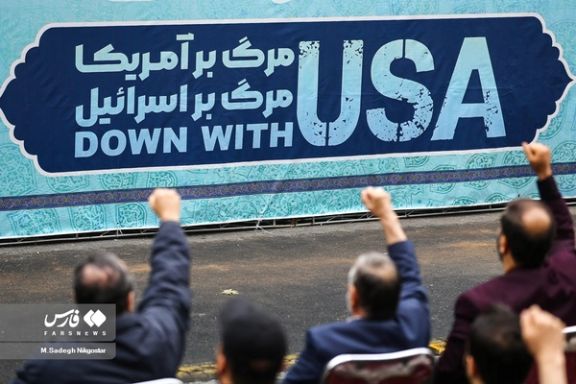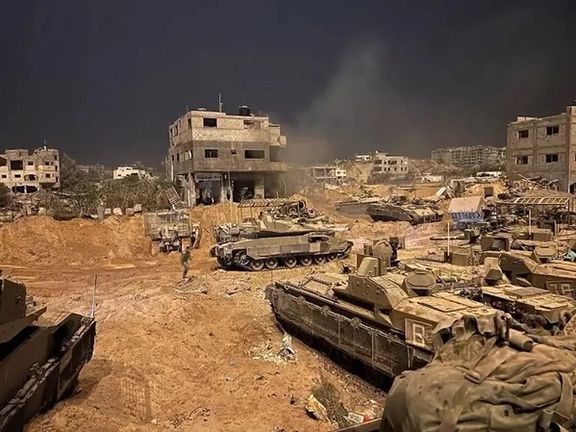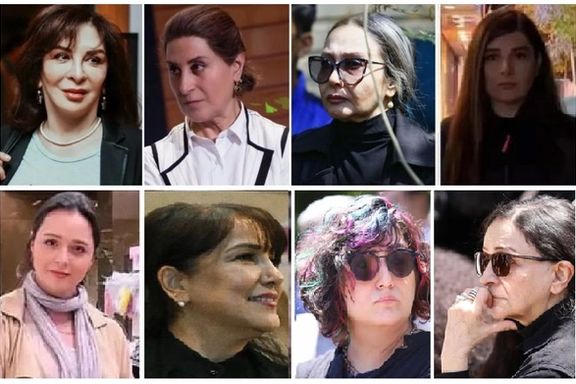Iran's VP Proposes New Economic Measures Amid Crisis

Iran's Vice President Mohammad Mokhber proposed new economic policies this week amid an ongoing national crisis.

Iran's Vice President Mohammad Mokhber proposed new economic policies this week amid an ongoing national crisis.
Speaking at the 6th China International Import Expo on Sunday, Mokhber introduced six initiatives aimed at reshaping global trade patterns.
Mokhber's proposals include “the expansion of electronic trade, the establishment of international centers, and backing the development of the multilateral trade system for organizing international regulations.”
Meanwhile, at home, mounting inflation and currency devaluation continues to drive the population into worsened poverty.
As negotiations with the United States and Europe regarding Tehran's nuclear program remain unresolved and US sanctions persist, Iran is increasingly looking to Asian countries, particularly China, for trade relations. However, China has yet to significantly challenge US sanctions and has been strengthening ties with Persian Gulf Arab countries and Israel.
In March 2021, Iran entered into a controversial 25-year agreement with China, initially proposed by Iran's Supreme Leader Ali Khamenei during President Xi's visit to Tehran in 2016. Many Iranians have expressed dissatisfaction with the cooperation agreement with China, viewing it as a compromise of national interests.
Iran experiences an inflation rate of over 50 percent. The significant depreciation of the Iranian rial reflects the inflationary pressures in the country, causing increased costs for imports and, subsequently, higher prices for consumers.
While large-scale protests in 2022 primarily centered on social and political issues, the current economic crisis is fueling discontent among disillusioned youth. Labor unrest has also been on the rise in 2023 as real incomes of workers continue to erode.

Iranian hardliners have once more threatened the United States, Britain and France with escalation of the war in Gaza, as they avoid direct involvement.
The latest threat came in the form of a resolution Saturday, delivered at the end of the state-organized rally to mark the anniversary of the infamous 1979 takeover of the US embassy in Tehran.
In that attack 44 years ago, hardline supporters of Ayatollah Ruhollah Khomeini, the founder of the Islamic Republic, stormed the US embassy and took more than 50 US personnel hostage for 444 days.
“Our guns are restless and your skulls are in sight,” was perhaps the most explicit part of the resolution, addressing “the US, Britain, and France.”
Such resolutions in Iran are, in fact, pieces of official propaganda and not independent positions expressed in popular events. This latest one comes in the wake of the admission by Ali Khamenei, Leader of the Islamic Republic that “Death to America is not just a slogan, it’s a policy.”
The regime in Iran has been markedly aggressive in tone since Hamas attacked Israel, trying perhaps to make up for its lack of direct action in support of Hamas.

“The Axis of Resistance is not limited to Gaza and Palestine,” the rally resolution reads. “If the bombardment and the barbaric slaughter of the oppressed people of Gaza does not stop, you shouldn’t consider any scenario unlikely.”
Despite the rhetoric, the Iranian regime has so far avoided conflict with Israel and has utilized loyal militants in Yemen, Syria and Iraq instead. The strongest of these groups, Hezbollah of Lebanon, has followed, so far staying away from an open, full-blown war with Israel.
In his much-anticipated speech Friday, Hezbollah leader Hassan Nasrallah was quite diplomatic, not committing his forces to what could be a disastrous war with Israel.
Nasrallah put much stress on the operational independence of Hamas, which he claims, had kept secret their October 7 attack from Hezbollah and Iran.
In Washington, the State Department issued a statement on the anniversary of the storming of the US embassy in Tehran.
“The Iranian regime has a long history of unjustly detaining foreign nationals that continues today,” reads the statement. “We condemn Iran’s continued detention of foreign citizens for use as bargaining chips.”
In September, the Biden administration managed to negotiate the release of five Iranian-Americans who were held hostage in Iran. To do so, it agreed to unfreeze $6 billion of Iran’s frozen oil revenues.
The deal was widely criticized even before it materialized. The criticism, however, became harsher after Hamas attacked Israel on October 7, killing 1400 and taking at least 200 hostage.
Biden critics claim there’s a direct link between the deal and the attack, since Hamas is supported and funded by the regime in Iran. Many also point out the fact that Iran’s oil revenue has rapidly increased during his tenure, allowing the regime to fund its “malign” activities.
House Majority Leader Steve Scalise repeated this attack line Friday –setting the state for the House to pass a bill to further restrict Iran’s oil exports.
“Iran has made $80 billion selling oil since Biden took office—as they bankroll Hamas’s terror,” he posted on X. “The House Republican Majority will take strong action to sanction their oil exports. Biden must be with us.”

The US military has announced the deployment of another aircraft carrier strike group to the Middle East amidst the ongoing conflict between Israel and Hamas.
The US military has announced the deployment of another aircraft carrier strike group to the Middle East amidst the ongoing conflict between Israel and Hamas.
The decision to send the USS Dwight D. Eisenhower and accompanying warships to the Eastern Mediterranean comes in response to the invasion of thousands of Hamas militia into Israel on October 7. It resulted in the loss of at least 1,400 mostly civilian lives and at least 431 hostages taken to Gaza in the single most deadly day in Jewish history since the Holocaust.
The United States aims to support the USS Gerald Ford in the region to prevent further escalation of the conflict as US bases in Iraq and Syria have already come under fire from Iranian proxies in recent weeks.
In addition to the naval deployment, the United States has also dispatched over two thousand Marines to the Middle East. The Biden administration has consistently issued public warnings to Iran and its proxies to avoid escalating the conflict in the region. President Biden has directly conveyed his message to Iran and Hezbollah, emphasizing, "Don't. Don't. Don't. Don't."
According to a statement by US Central Command, the strike group is under the command of Carrier Strike Group 2 and is composed of the flagship aircraft carrier USS Dwight D. Eisenhower, guided-missile cruiser USS Philippine Sea, and guided-missile destroyers USS Mason as well as USS Gravely of Destroyer Squadron 22. Carrier Air Wing 3, with its nine squadrons, and the Information Warfare Commander are also part of the deployment.

Arab leaders publicly pressed US Secretary of State Antony Blinken on Saturday to secure an immediate ceasefire in Gaza, as Iran continued to use threatening rhetoric.
In a rare open display of disagreement, the top US diplomat pushed back as he stood next to his Jordanian and Egyptian counterparts at a news conference, saying a ceasefire would only let Hamas regroup and launch more attacks on Israel. Earlier, the US had spoken of a humanitarian pause.
Blinken met the Saudi, Qatari, Emirati, Egyptian and Jordanian foreign ministers in Amman four weeks after Hamas fighters burst over the border into Israel, killing 1,400 people and taking more than 240 people hostage.
"Right now, we have to make sure that this war stops," Jordanian Foreign Minister Ayman Safadi told the news conference.
Blinken said all were agreed on the need for peace and that the current status quo in Gaza cold not hold, but he acknowledged there were differences between Washington, which has called only for pauses to led aid into Gaza, and its allies.

"A ceasefire now would simply leave Hamas in place, able to regroup and repeat what it did on October 7," said Blinken, on his second trip to the region since Israel and Hamas went to war. "No nation, none of us would accept that."
The Iranian regime, which has so far refrained from any direct involvement in the war, staged rallies on Saturday to highlight the takeover of the US embassy in Tehran in November 1979 that resulted in American diplomats being held hostage for 444 days. Anti-American rhetoric was rampant by officials and government media, as the regime has been trying to shift the blame for Israel’s retaliatory attack on Gaza to the United States.
Reports emerged of Hamas leader Ismail Haniyeh having met Iran’s ruler Ali Khamenei in recent days, traveling from Qatar to Tehran. No details were available about the talks.
Israel continued its air and ground operations in Gaza accompanied by a barrage of accusations that civilian targets were hit. However, it is extremely difficult to say what locations or vehicles are being used by Hamas, which often uses civilian buildings for military purposes.

Israel last month ordered all civilians to leave the northern part of the Gaza Strip, including Gaza City where it says Hamas militants are hiding in tunnels, and head to the south of the enclave.
The military said it would enable Palestinians to travel on a main Gaza Strip highway, the Salah a-Din road, during a three-hour window on Saturday afternoon. "If you care about yourself and your loved ones, heed our instruction to head south," it said in a social media post in Arabic.
Several residents told Reuters they were too afraid to use the road due to Israeli forces and many posted warnings on social media that Israeli tanks were stationed on it. At the same time they were social media reports accusing Hamas of firing on the road during the time window for civilians to leave.
US Special Envoy David Satterfield said in Amman that between 800,000 to a million people had moved to the south of the Gaza Strip, while 350,000-400,000 remained in northern Gaza City and its environs.
Israel has imposed a full blockade on Gaza and allowed very little aid in from Egypt, saying it fears it would be stolen by Hamas. Satterfield said there were no recorded instances of Hamas seizing aid.
In what appeared to presage a widening of Israel's ground offensive, the military issued footage showing armored bulldozers churning up northern Gaza areas in what it described as "creating access routes for forces".
A combined tank and combat engineering unit carried out a "pinpoint raid" in the southern Gaza Strip "to map out buildings and neutralize explosives", it said.
Lebanon's Hezbollah said it carried out simultaneous attacks on Israeli positions at the Lebanese border on Saturday, as residents of south Lebanon reported some of the fiercest Israeli strikes yet during weeks of cross-border clashes.
The Israeli army said its warplanes had struck Hezbollah targets in response to an earlier attack from Lebanese territory and was accompanying the air strikes with artillery and tank shelling.
The Hezbollah movement in Lebanon is backed by Iran, as is Hamas. Hezbollah leader Sayyed Hassan Nasrallah on Friday warned that conflict could spread if Israel continued bombing Gaza.
Pro-Palestinian protests took place on Saturday in European capitals including London, Berlin and Paris to call for an immediate ceasefire.
With reporting by Reuters

The leader of the Palestinian group Hamas, Ismail Haniyeh, met Iranian Supreme Leader Ayatollah Ali Khamenei during a visit to Tehran in recent days.
A Hamas official reveled the news about the meeting on Saturday in remarks broadcast by al-Mayadeen television affiliated with the Iranian regime.
Osama Hamdan, a senior official in the Iran-backed Hamas, gave no further details about the visit to Tehran, speaking in Beirut. However Iranian official media was silent about the meeting on Saturday.
Haniyeh has resided between Qatar and Turkey since 2019. Both countries are close supporters of Hamas, with Qatar providing hundreds of millions of dollars annually to the militant Islamist group.
However, Khamenei and his Islamic regime in Tehran have been the main military backers of Hamas, providing weapons and training through their network of militant proxy forces in the region, including the Lebanese Hezbollah. However, the Iranian regime has so far stopped short of direct involvement in the Israel-Hamas conflict.
The United States has deployed two powerful naval strike groups led by large aircraft carriers in the eastern Mediterranean, in addition to reinforcing its presence in the Persian Gulf in the summer.
Haniyeh had already met with Iran’s foreign minister Hossein Amir-Abdollahian in Qatar on October 31.

The head of Iran's Cinema Organization has defended the ban on several actresses who removed their hijab in solidarity with the Woman, Life, Freedom protests last year.
The anti-regime protests in 2022 gained momentum following the tragic death of Mahsa Amini while in hijab police custody, leading to a wave of outrage. In a show of solidarity with the protests, a number of Iranian actresses publicly shared images of themselves without the obligatory hijab.
The government official in charge of strictly regulating the cinema industry, Mohammad Khazaei, indirectly mentioned that the condition for lifting the ban on the actresses' work is an "apology for violating the mandatory hijab." He implied in a TV program that the ban's removal is contingent on the actresses "changing their approach."
Khazaei also pointed out that the legal authority for implementing the ban on the female artists lies with either the judiciary or security agencies, suggesting that the decision to prohibit their work had been made outside the realm of the Cinema Organization.
Responding to protests by filmmakers and cinema professionals who opposed the ban, Khazaei claimed that the Cinema Organization follows the orders and directives of the judiciary and security agencies.
Earlier, Mohammad Mehdi Esmaili, the Minister of Culture, once again confirmed the ban on actresses who had refused to wear the mandatory hijab. On October 25, Iran officially released a list of actresses who are now prohibited from working in the film industry due to their non-compliance with the hijab requirement.
The list of affected actresses includes several well-known figures in the Iranian film industry, such as Baran Kosari, Vishka Asayesh, Taraneh Alidousti, Katayoun Riahi, Panteha Bahram, Hengameh Ghaziani, Pegah Ahangarani, and others.